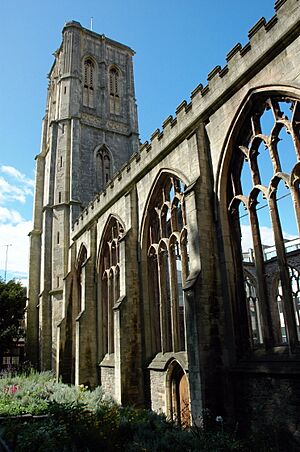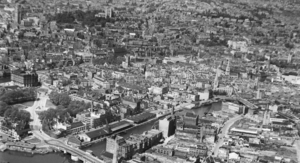Bristol Blitz facts for kids
Quick facts for kids Bristol Blitz |
|||||||
|---|---|---|---|---|---|---|---|
| Part of the Strategic bombing campaign of World War II | |||||||
 Bomb-damaged buildings and the remains of St Mary le Port church (left) viewed from the south east, following a bombing raid on the area now known as Castle Park |
|||||||
|
|||||||
| Belligerents | |||||||
| Casualties and losses | |||||||
| Unknown | 1299 killed, 1303 injured | ||||||
The Bristol Blitz was a series of big bombing attacks on Bristol, England. These attacks were carried out by the German air force, known as the Luftwaffe, during World War II. Bristol was a major target because it had a busy Bristol Harbour and the important Bristol Aeroplane Company. German bombers could easily find the city by following the River Avon from Avonmouth, especially when moonlight reflected on the water. Bristol was the fifth-most bombed British city during the war.
Between November 24, 1940, and April 11, 1941, Bristol faced six major bombing raids. In total, the city had 548 air raid warnings and 77 actual air raids.
- 919 tons of high-explosive bombs were dropped. Many thousands of incendiary bombs (fire bombs) were also dropped in groups.
- 1,299 people were killed, and 1,303 were seriously injured. Another 697 people were rescued from damaged buildings.
- 89,080 buildings were damaged. This included 81,830 houses, with over 3,000 houses completely destroyed or made unusable.
Contents
First Bombing Attacks
On November 2, 1940, during a night raid, 5,000 incendiary (fire) bombs and 10,000 high-explosive bombs were dropped on the old city.
On November 24, 148 German bombers headed for Bristol. The attack began at 6:30 PM. Waves of bombers flew over the city, dropping about 12,000 incendiary bombs and 160 tons of high-explosive bombs. Within an hour, more than 70 fires had started. Park Street was badly damaged, and the Bristol Museum was hit. 207 people died, and thousands of houses were destroyed or damaged. The area now known as Castle Park was heavily damaged. The old St Peter's Hospital, built in the Jacobean style, was destroyed. The 17th-century timber-framed Dutch House was also damaged and later taken down. Four of Bristol's historic churches were badly hit: St Peter's, St Nicholas, St Mary-le-Port, and Temple Church. The St James' Presbyterian Church of England, Bristol was also gutted.
The Lord Mayor of Bristol, Alderman Thomas Underwood, said that after the raids, "The City of Churches had in one night become the city of ruins."
On December 7, 1940, bombs hit a train traveling from Bristol to Salisbury. Several passengers, including soldiers, were killed.
Later Bombing Attacks
On January 3–4, 1941, Bristol experienced its longest raid, which lasted 12 hours. During this attack, the German air force dropped its biggest bomb on the city. It was nicknamed "Satan" and weighed about 2,000 kilograms (4,400 pounds). It was over 2.4 meters (8 feet) long without its tail and 66 centimeters (26 inches) wide. This huge bomb did not explode. It was found and removed in April 1943. The bomb disposal team had to dig down 8.8 meters (29 feet) to reach it. The bomb was later shown in the streets of London during the VE Day Victory Parade.
Bristol Good Friday Air Raids
The famous Good Friday air raids caused more damage to the city center, Knowle, Hotwells, Cotham, and Filton. These raids also led to the permanent closure of the Bristol Tramways (the city's tram system). Winston Churchill, who was the Prime Minister at the time, visited the damaged areas on April 12, 1941. The last major air raid of the Blitz on Bristol happened on April 25, 1941. During this raid, Brislington, Bedminster, and Knowle were bombed. It is thought that these areas were hit by mistake, as the bombs were likely meant for the manufacturing areas in Filton.
One common type of bomb dropped on Bristol was a container filled with many incendiaries (fire bombs). Locals called these "Goering's Bread Basket." These bombs caused many fires and were designed to create panic and overwhelm the fire services.
The very last air raid on Bristol happened on May 15, 1944.
Bristol was also at risk of being hit by V-1 flying bombs and V2 rockets. Launching platforms for these rockets had been built in France in 1944. However, the Allied invasion of Normandy on June 6, 1944, quickly captured these launch sites. Because of this, no V1 or V2 rockets ever landed on Bristol.
Decoy Sites

After the bombing of Coventry in November 1940, many fake bombing targets, called decoy sites, were built. Their purpose was to trick enemy bombers into attacking empty areas instead of major cities. The main decoy for Bristol was at Black Down in the Mendip Hills, about 24 kilometers (15 miles) southwest of Bristol. A smaller one was in the area of Chew Magna. These were known as starfish sites. They were designed to look like Bristol at night during a blackout, even copying the flickering lights of railway yards. If an air raid was expected, lights would be turned on at these decoy sites to draw the bombers away.
Images for kids



